Harold and the Arrow
The battle of Hastings is arguably the most well-known event in English history, and it is common knowledge that King Harold was killed by an arrow in the eye. This well-known ‘fact’ is, however, not at all certain.
William of Jumièges, in his brief record of the fighting, which started around 9 a.m. and carried on till nightfall, asserts that Harold:
… fell in the first shock of battle, pierced with lethal wounds.(VII, 15)
Orderic Vitalis repeats William of Jumièges’ highly unlikely claim (since the battle lasted the whole day) that Harold was killed in the opening clash, but gives no indication at all as to the manner of his death[*].
The Anglo-Saxon Chronicle simply says that Harold was “slain” (Manuscript D); “fell” (Manuscript E). Florence of Worcester, though, reports:
… about twilight the king, alas! fell.
According to the Carmen de Hastingae Proelio:
Now the victor, joyful France almost ruled the field; already she was seeking the spoils of war when the duke sighted the king far off on the steeps of the hill, fiercely hewing to pieces the Normans who were besetting him. He [Duke William] called Eustace [count of Boulogne] to him … Hugh, the noble heir of Ponthieu, escorted these two … fourth was Gilfard, known by his father’s surname: these four bore arms for the destruction of the king… The first, cleaving his [Harold’s] breast through the shield with his point, drenched the earth with a gushing torrent of blood; the second smote off his head below the protection of the helmet and the third pierced the inwards of his belly with his lance; the fourth hewed off his thigh and bore away the severed limb:[*] the ground held the body thus destroyed.(lines 531–550)
On hearing of Harold’s death, the remaining English forces flee into the gathering darkness.
William of Poitiers doesn’t implicate Duke William in Harold’s death, nor does he mention the manner of it, though the wounds Harold had suffered had destroyed his features:
The king’s two brothers were found lying beside him. He himself, all dignity lost, was recognized not by his face but by certain indications …(II, 25)
The Bayeux Tapestry (which places Harold’s death just before the remaining Englishmen flee the battlefield), however, clearly shows Harold clutching at an arrow protruding from his eye –
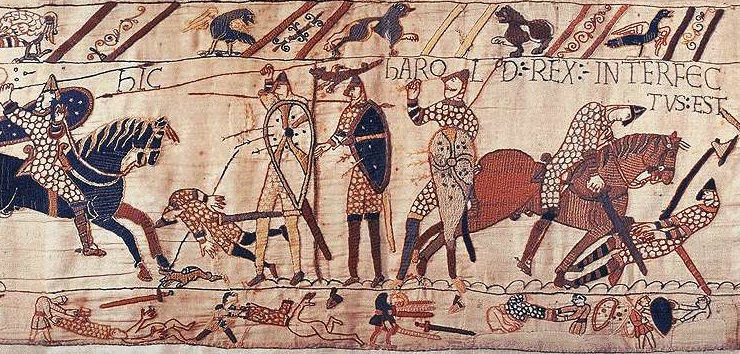
In the lower margin, as mentioned by the Carmen, “the spoils of war” are being stripped from dead Englishmen.
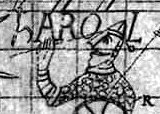
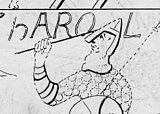
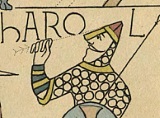
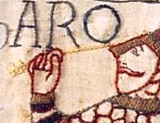
– well perhaps not. It isn’t actually clear which figure represents Harold. It may well be that the Englishman being hacked to the ground under the words INTERFECTUS EST (“is slain”) represents the king, and not the one beneath the name HAROLD,[*] who is gripping the shaft of an arrow that seems to project from the right side of his face – supposing it really is an arrow! When the Tapestry’s historical importance was noticed, in the 18th century, it was considerably more threadbare than it looks now. A drawing made by one Antoine Benoît, for Bernard de Montfaucon, who published engravings based on the drawing in 1730, indicates that the feather flights, which identify the shaft as belonging to an arrow (rather than a spear about to be launched at the approaching Norman horsemen), were not discernible. However, in 1816 the Society of Antiquaries of London directed their historical draughtsman, Charles Stothard, to make a drawing of the Tapestry, coloured engravings of which were subsequently published, and he apparently noticed the stitch-holes of arrow fletchings.[*] It is not impossible, though, that Stothard interpreted such evidence as he found as an arrow because that is what he expected to find. Later in the 19th century the Tapestry underwent major ‘restoration’, and it now shows an Englishman grasping a gold-coloured arrow, that is seemingly stuck in his right eye.




The Bayeux Tapestry, then, does not itself provide conclusive evidence that Harold was shot in the eye. However, William of Malmesbury (writing some six decades after the battle of Hastings) apparently adopted elements from the story told by the Tapestry into his own narrative (he could have seen the Tapestry itself, or maybe he had access to the account on which it was based), and he says that Harold:
… fell, from having his brain pierced with an arrow … receiving the fatal arrow from a distance, he yielded to death.[*] One of the soldiers with a sword gashed his thigh, as he lay prostrate; for which shameful and cowardly action he was branded with ignominy by William, and expelled from the army.(GR III §§242–243)
Assuming William of Malmesbury really is referencing the account of Harold’s death depicted in the Tapestry, then a couple of things are indicated – that the fellow in the Tapestry is indeed clutching an arrow, and that William of Malmesbury understood both him and the chap being hacked at from horseback to represent Harold.[*]
Henry of Huntingdon, writing just a few years after William of Malmesbury:
… Duke William instructed the archers not to shoot their arrows directly at the enemy, but rather into the air, so that the arrows might blind the enemy squadron. This caused great losses among the English. Twenty of the most valiant knights gave their word to one another that they would break through the English line and snatch away the royal banner, which is called the ‘Standard’. When they went to do this, several of them were killed. But some of them, making a way with their swords, carried off the Standard. Meanwhile the whole shower sent by the archers fell around King Harold, and he himself sank to the ground, struck in the eye. A host of knights broke through and killed the wounded king, and Earl Gyrth and Earl Leofwine, his brothers, with him.[*](VI, 30)
Later, Master Wace (Roman de Rou), who was a canon at Bayeux, composed a further development of the theme:
Then it was that an arrow, that had been thus shot upwards, struck Harold above his right eye, and put it out. [Harold is hit by the arrow fairly early in the battle, presumably to accommodate William of Jumièges’ statement.] In his agony he drew the arrow and threw it away, breaking it with his hands; and the pain was so great that he leaned upon his shield… And now [a considerable time later] the Normans had pressed on so far, that at last they reached the standard. There Harold had remained, defending himself to the utmost; but he was sorely wounded in his eye by the arrow, and suffered grievous pain from the blow. An armed man came in the throng of the battle, and struck him on the ventail of his helmet, and beat him to the ground; and as he sought to recover himself, a knight beat him down again, striking him on the thick of his thigh, down to the bone. [Gyrth is killed, Leofwine is not mentioned] … The standard was beaten down, the golden gonfanon was taken, and Harold and the best of his friends were slain; but there was so much eagerness, and throng of so many around, seeking to kill him, that I know not who it was that slew him… I do not tell, and I do not indeed know, for I was not there to see, and have not heard say, who it was that smote down King Harold, nor by what weapon he was wounded; but this I know, that he was found among the dead.
What subsequently became of Harold’s body is, again, uncertain. According to the Carmen de Hastingae Proelio:
After the glorious light of the sun began to shine and cleanse the world of brooding darkness, the duke surveyed the field, and taking up the bodies of his fallen, he buried them in the bosom of the earth. The corpses of the English, strewn upon the ground, he left to be devoured by worms and wolves, by birds and dogs. Harold’s dismembered body he gathered together, and wrapped what he had gathered in fine purple linen, and returning to his camp by the sea, he bore it with him, that he might carry out the customary funeral rites.(lines 567–576)
In exchange for the body, Harold’s mother offers to give its weight in gold to the duke, but an “infuriated” William refuses:
… swearing that he would sooner entrust the shores of that very port to him – under a heap of stones! Therefore, even as he had sworn, he commanded the body to be buried in the earth on the high summit of a cliff; and forthwith a certain man, part Norman, part English, Harold’s comrade, willingly did his behest; for he swiftly took up the king’s body and buried it, setting over it a stone, and he wrote as epitaph:By the duke’s commands, O Harold, you rest here a king,
That you may still be guardian of the shore and sea.(lines 583–592)
William of Poitiers maintains that Duke William, although he could have legitimately insisted the English dead be left on the battlefield to become dinner for wild animals, chose to allow anyone who so wished to take bodies away for burial. William of Poitiers does, however, agree that the duke refused to accept Harold’s body-weight in gold from his mother:
… the duke entrusted his burial to William surnamed Malet, and not to his mother … he held Harold to be unworthy of burial as his mother wished, when his greed was the cause of so many others lying unburied. It was said in mockery to be appropriate to leave him as the keeper of the shore and sea which he had so recently sought to defend in his insanity.(II, 25)
William of Malmesbury, however, claims that:
He [Duke William] sent the body of Harold to his mother (who begged it), unransomed, though she proffered large sums by her messengers. She buried it, when thus obtained, at Waltham; a church he [Harold] had built at his own expense, in honour of the Holy Cross, and which he had filled with canons.(GR III §247)
Wace too says Harold was taken to Waltham (a dozen, crow-flying, miles to the north of the City of London):
… but I know not who it was that bore him thither, neither do I know who buried him.(Rou: ii, 286)
According to the Waltham Chronicle, produced soon after 1177, Harold visited Waltham after his victory at Stamford Bridge.[*] Two of the Waltham canons, Osgod Cnoppe and Æthelric Childemaister, joined his retinue. After the battle of Hastings they obtained Duke William’s permission to take Harold’s body (William refused payment) to Waltham. They were unable to recognize the king, however, and so Osgod fetched Harold’s former concubine, Edith Swan-neck, who, from “secret marks”, identified the corpse. It was taken to Waltham and buried “with great honour”.[*]
There were also stories in circulation that Harold had actually survived the battle. Ailred of Rievaulx, writing c.1163, noted:
… Harold himself was deprived of the kingdom of England, and either died wretchedly or, as some think, escaped to a life of penitence.Vita Sancti Edwardi Regis et Confessoris Ch.21[*]
The anonymous author of the Waltham Chronicle had heard tales (which he knew to be invented, because Harold was certainly buried at Waltham) that Harold had lived in a cave at Canterbury, and when he died was buried at Chester. The anonymous author of the Vita Haroldi, composed some three decades after the Waltham Chronicle, maintains that Edith Swan-neck had made a mistake – the “mangled corpse” buried at Waltham was not Harold. Harold, seriously wounded, had been restored to full-health, over a two year period, by a Saracen woman in Winchester. After travels in Europe, lasting “many years”, he had returned to England, spending ten years living a solitary life in a cave near Dover, then “a long time” in the Welsh borderlands, and eventually ending his days as a hermit at Chester.[*]
